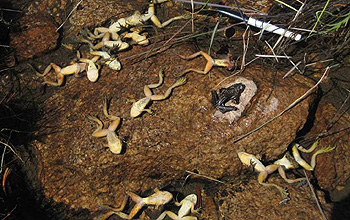 NSF, NIH Award Ecology of Infectious Diseases Grants
NSF, NIH Award Ecology of Infectious Diseases Grants
National Science Foundation - www.nsf.gov
29 Oct 2007
Photo courtesy of Cheryl Briggs, UCSB
Scientists to study interaction of environment, disease processes
Over the last several decades, environmental changes have coincided with the emergence and re-emergence of numerous infectious diseases around the world. To address this problem, the National Science Foundation (NSF)'s Directorates for Biological Sciences and Geosciences and the National Institutes of Health (NIH)'s Fogarty International Center (FIC) and National Institute of Environmental Health Sciences have announced funding for eight projects under the Ecology of Infectious Diseases (EID) program, a multiyear, joint-agency effort now in its eighth year of funding. "Understanding the causes and consequences of emerging infectious diseases is among the grand challenge questions in the environmental sciences," said James Collins, NSF assistant director for biological sciences.
"These awards will help provide the basic knowledge we need to develop models for forecasting the emergence and spread of new and old pathogens." "These projects will help ecologists discover basic insights about disease transmission, and help public health officials make complex decisions about disease prevention measures and their potential trade-offs with other environmental health risks," said Roger Glass, director of NIH's FIC. Interdisciplinary projects funded through the EID program will study how environmental events--such as habitat destruction, biological invasions, and pollution--alter the risks of viral, parasitic and bacterial diseases now emerging in humans and animals. The coincidence of the emergence of these infectious diseases and large-scale environmental changes may point to underlying and predictable ecological relationships, said Sam Scheiner, program director in NSF's division of environmental biology. "Fundamental research is critical for preparing for possible disease outbreaks, as well as for optimizing public health and environmental management responses to chronic infectious diseases," he said.
Mass Bird Death Raising Questions
North Kitsap Herald - www.northkitsapherald.com
27 Oct 2007
A Tietje
Area: Washington United States
The Suquamish Tribe and the Washington State Department of Fish and Wildlife are working in concert to determine why 209 common murres and Pacific loons washed up dead on the Indianola beach Monday. While there had been no apparent oil or gasoline spills in the area, residents started noticing the carcasses earlier this week, and tribal officials reported their findings to the state crews. Suquamish Tribal Fisheries Biologist Paul Dorn said there could be a number of different reasons for the mass death, among them drowning, pollution, poisoned food or fishing via purse seining. He and other tribal workers helped collect the bodies and samples to send to the Fish and Wildlife laboratories to establish the cause of death.
“This is a hugely sad event,” he said. “These were not endangered birds, but they are not common either... We received calls Monday morning. We’re responding, but we don’t know the cause yet.” Fish and Wildlife District Wildlife Biologist Greg Schirato said this is definitely not a case of bird flu, but there is a hotline open for residents to call if they see a large die-off similar to this one. “This particular case is unusual,” he said. “In quite a few years, I’ve dealt with bird wash ups for quite a few years on this beach, and this one is different.”
 Town Hit by Rabbit Disease
Town Hit by Rabbit DiseaseWigan Today - www.wigantoday.net
29 October 2007
R Bean
Area: England United Kingdom
A deadly disease which has left millions of animals dead worldwide has broken out in Wigan. Vets across the borough have been called on to put down increasing numbers of rabbits because of a renewed outbreak of myxomatosis. This summer's warm, wet conditions have been ideal for the breeding cycle of biting insects like mosquitoes and horseflies – which carry the virus – to flourish. Pet rabbits can pick up myxomatosis from other infected wild cousins, but it is more commonly spread by fleas and can even be transmitted via cats and dogs if they hunt wild rabbits.
. . . Myxomatosis was a man-made disease cultured in the 1950s to control the rabbit population in Australia, where their huge numbers were wiping out crops. It almost wiped out the native population of rabbits when it was illegally introduced into Britain almost a decade later. Symptoms of the disease are runny eyes and swollen genitals, followed by severe swelling of the eyes and eyelids, leading to blindness. Walkers should also look out for rabbits with swollen head and ears along with further swellings on the skin.
 Flu Lab Nears Completion
Flu Lab Nears CompletionWisconsin State Journal - www.madison.com
29 Oct 2007
D Wahlberg
Photo courtesy of C Schreiner - State Journal
Area: Wisconsin United States
Ten-inch walls made with crack-resistant concrete. Outlets sealed with silicone. Sensors for broken windows. Infrared surveillance beams. Redundant air handling systems. A back-up generator. UW-Madison's $12.5 million Institute for Influenza Viral Research, nearing completion at University Research Park, will have a collection of safety and security features the university hasn't seen before. Many people will be watching the work of the institute, to be directed by virologist Yoshihiro Kawaoka.Ten-inch walls made with crack-resistant concrete. Outlets sealed with silicone.Sensors for broken windows.
Infrared surveillance beams. Redundant air handling systems. A back-up generator. UW-Madison's $12.5 million Institute for Influenza Viral Research, nearing completion at University Research Park, will have a collection of safety and security features the university hasn't seen before. Many people will be watching the work of the institute, to be directed by virologist Yoshihiro Kawaoka.
OTHER WILDLIFE DISEASE RELATED NEWS
- Global Animal Health Initiative: The Way Forward
- Minnesota TB Investigation Discovers 8th Infected Cattle Herd
- Fishing with Caution (includes video)
WILDLIFE DISEASE RELATED PUBLICATIONS
The Wildlife Professional
Volume 1, Issue 3
Melting Under Pressure [PDF]
The Wildlife Professional. 2007 Sep; 1(3); 24-27
I Stirling and A E Derocher
Resources for Wildlife Professionals [PDF]
The Wildlife Professional. 2007 Sep; 1(3); 36-39
CB Love and JF Kramer





No comments:
Post a Comment